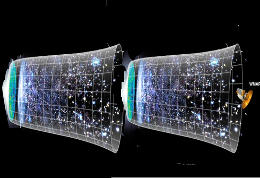The universe before the big bang
 Details anomalies detected in the cosmic microwave background radiation may indicate that we are in a cyclic universe , in which the end of each "aeon" a new big bang would give way to a new universe.
Details anomalies detected in the cosmic microwave background radiation may indicate that we are in a cyclic universe , in which the end of each "aeon" a new big bang would give way to a new universe.
To ask what happened before the Big Bang may seem unscientific, since that time itself would not have existed if not after that about 13.7 billion years ago.
However, as explained in an article posted on the website arXiv , Roger Penrose, University of Oxford and Vahe Gurzadyan of Yerevan State University, Armenia, identified in the cosmic microwave background (CMB), an effect that would seem to allow "look beyond" the Big Bang, to see what was there before.
The cosmic microwave background radiation that permeates the universe is believed to be a remnant of when the universe was newborn. In the nineties it was discovered that this radiation is anisotropic, ie its temperature fluctuates by about one part in 100,000, representing one of the main observational data in favor of the Big Bang theory. These fluctuations should be random, and dating from the period of "inflation" of the universe that you believe there has been a fraction of a second after the Big Bang.
Penrose and Gurzadyan have now discovered, however, the presence of a series of concentric circles within the CMB, within which the temperature variation is much less than the expected, a fact which shows how the anisotropy is not entirely random. The two scientists believe that these circles arise from collisions between supermassive blacks holes that would release huge "bursts of energy". The most striking aspect of these circles is that, according to the researchers' calculations, some of the larger circles should be formed before the Big Bang.
The discovery, observe Penrose and Gurzadyan, does not imply that there was a Big Bang, rather provides an indication of the possibility of being in a sort of cyclic universe, in which the end of a "aeon" or universe, would trigger a new Big Bang which marks the beginning of a new universe, in a process would be repeated indefinitely. According to Penrose and Gurzadyan the clash of the blacks holes that led to the circles, would take place right at the end of the aeon prior to that of our universe.
Penrose had previously studied the possible cyclic cosmological models in relation to another problem of inflationary theory of the universe, namely that it is not able to explain why there was such a low entropy at the beginning of the universe. The state of low entropy , ie of high order , it was essential for the formation of the complex material. The underlying idea is that when the cosmology cyclic universe has expanded as much as possible, the blacks holes "evaporate" losing all the information they contain, thus removing the entropy. At this point a new eon could start with a state of low entropy.
Given the importance that they can take these circles, the researchers point out, it is still necessary to further substantial work, both to confirm its existence, is to explore the possibility that there are other models that can explain it better. To detect circles and eliminate the risk of an eventual instrumental cause, Penrose and Gurzadyan have so far used the data obtained from two experiments, WMAP and BOOMERanG98 .


 Details anomalies detected in the cosmic microwave background radiation may indicate that we are in a cyclic universe , in which the end of each "aeon" a new big bang would give way to a new universe.
Details anomalies detected in the cosmic microwave background radiation may indicate that we are in a cyclic universe , in which the end of each "aeon" a new big bang would give way to a new universe.
